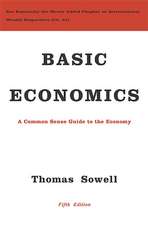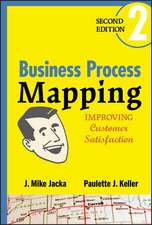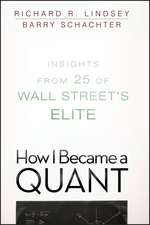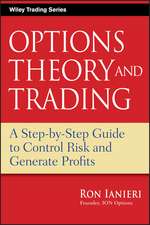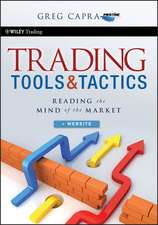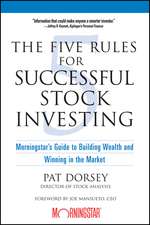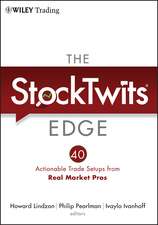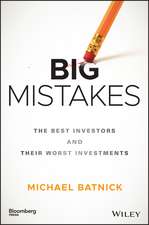The Investment Checklist – The Art of In–Depth Research
Autor M Shearnen Limba Engleză Hardback – 15 dec 2011
Preț: 266.39 lei
Nou
Puncte Express: 400
Preț estimativ în valută:
50.98€ • 53.03$ • 42.09£
50.98€ • 53.03$ • 42.09£
Carte disponibilă
Livrare economică 24 martie-07 aprilie
Livrare express 07-13 martie pentru 41.16 lei
Preluare comenzi: 021 569.72.76
Specificații
ISBN-13: 9780470891858
ISBN-10: 0470891858
Pagini: 384
Dimensiuni: 161 x 239 x 35 mm
Greutate: 0.59 kg
Editura: Wiley
Locul publicării:Hoboken, United States
ISBN-10: 0470891858
Pagini: 384
Dimensiuni: 161 x 239 x 35 mm
Greutate: 0.59 kg
Editura: Wiley
Locul publicării:Hoboken, United States
Public țintă
Individual Investors, Investment Managers, Investment ProfessionalsCuprins
Preface xi Acknowledgments xix Chapter 1 How to Generate Investment Ideas 1 How Investment Opportunities Are Created 1 How to Filter Your Investment Ideas 14 Using a Spreadsheet to Track Potential and Existing Holdings 19 Chapter 2 Understanding the Business--The Basics 21 1. Do I want to spend a lot of time learning about this business? 22 2. How would you evaluate this business if you were to become its CEO? 23 3. Can you describe how the business operates, in your own words? 26 4. How does the business make money? 28 5. How has the business evolved over time? 29 6. In what foreign markets does the business operate, and what are the risks of operating in these countries? 30 Chapter 3 Understanding the Business--from the Customer Perspective 39 7. Who is the core customer of the business? 41 8. Is the customer base concentrated or diversified? 42 9. Is it easy or diffi cult to convince customers to buy the products or services? 43 10. What is the customer retention rate for the business? 44 11. What are the signs a business is customer oriented? 46 12. What pain does the business alleviate for the customer? 49 13. To What degree is the customer dependent on the products or services from the business? 49 14. If the business disappeared tomorrow, what impact would this have on the customer base? 50 Chapter 4 Evaluating the Strengths and Weaknesses of a Business and Industry 53 15. Does the business have a sustainable competitive advantage and what is its source? 54 16. Does the business possess the ability to raise prices without losing customers? 68 17. Does the business operate in a good or bad industry? 73 18. How has the industry evolved over time? 77 19. What is the competitive landscape, and how intense is the competition? 79 20. What type of relationship does the business have with its suppliers? 89 Chapter 5 Measuring the Operating and Financial Health of the Business 97 21. What are the fundamentals of the business? 98 22. What are the operating metrics of the business that you need to monitor? 100 23. What are the key risks the business faces? 105 24. How does infl ation affect the business? 111 25. Is the business's balance sheet strong or weak? 113 26. What is the return on invested capital for the business? 123 Chapter 6 Evaluating the Distribution of Earnings (Cash Flows) 137 27. Are the accounting standards that management uses conservative or liberal? 138 28. Does the business generate revenues that are recurring or from one- off transactions? 146 29. To what degree is the business cyclical, countercyclical, or recession-resistant? 148 30. To what degree does operating leverage impact the earnings of the business? 152 31. How does working capital impact the cash fl ows of the business? 162 32. Does the business have high or low capital-expenditure requirements? 167 Chapter 7 Assessing the Quality of Management--Background and Classification: Who Are They? 173 33. What type of manager is leading the company? 176 34. What are the effects on the business of bringing in outside management? 180 35. Is the manager a lion or a hyena? 183 36. How did the manager rise to lead the business? 186 37. How are senior managers compensated, and how did they gain their ownership interest? 192 38. Have the managers been buying or selling the stock? 202 Chapter 8 Assessing the Quality of Management--Competence: How Management Operates the Business 209 39. Does the CEO manage the business to benefi t all stakeholders? 210 40. Does the management team improve its operations day- to- day or does it use a strategic plan to conduct its business? 213 41. Do the CEO and CFO issue guidance regarding earnings? 219 42. Is the business managed in a centralized or decentralized way? 222 43. Does management value its employees? 225 44. Does the management team know how to hire well? 239 45. Does the management team focus on cutting unnecessary costs? 247 46. Are the CEO and CFO disciplined in making capital allocation decisions? 248 47. Do the CEO and CFO buy back stock opportunistically? 250 Chapter 9 Assessing the Quality of Management--Positive and Negative Traits 255 48. Does the CEO love the money or the business? 256 49. Can you identify a moment of integrity for the manager? 264 50. Are managers clear and consistent in their communications and actions with stakeholders? 268 51. Does management think independently and remain unswayed by what others in their industry are doing? 275 52. Is the CEO self-promoting? 276 Chapter 10 Evaluating Growth Opportunities 281 53. Does the business grow through mergers and acquisitions, or does it grow organically? 281 54. What is the management team's motivation to grow the business? 282 55. Has historical growth been profi table and will it continue? 283 56. What are the future growth prospects for the business? 284 57. Is the management team growing the business too quickly or at a steady pace? 296 Chapter 11 Evaluating Mergers & Acquisitions 305 58. How does management make M&A decisions? 305 59. Have past acquisitions been successful? 310 Appendix A Building a Human Intelligence Network 323 Evaluating Information Sources 324 How to Locate Human Sources 324 How to Contact Human Sources--and Get the Information You Want 328 Create a Database of Your Interviews for Future Reference 329 Appendix B How to Interview the Management Team 331 Ask Open- Ended Questions 332 Be Aware of the Danger of Face- to- Face Assessments of Managers 333 Appendix C Your Investment Checklist 335 Notes 339 About the Author 351 Index 353



